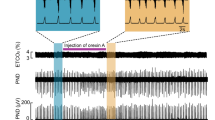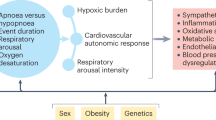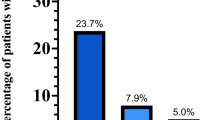Abstract
Acute hypercapnia (elevated arterial CO2/H+) is a suffocation signal that is life threatening and rapidly mobilizes adaptive changes in breathing and behavioral arousal in order to restore acid-base homeostasis. Severe hypercapnia, seen in respiratory disorders (eg, asthma or bronchitis, chronic obstructive pulmonary disease (COPD)), also results in high anxiety and autonomic activation. Recent evidence has demonstrated that wake-promoting hypothalamic orexin (ORX: also known as hypocretin) neurons are highly sensitive to local changes in CO2/H+, and mice lacking prepro-ORX have blunted respiratory responses to hypercapnia. Furthermore, in a recent clinical study, ORX-A, which crosses blood–brain barrier easily, was dramatically increased in the plasma of patients with COPD and hypercapnic respiratory failure. This is consistent with a rodent model of COPD where chronic exposure to cigarette smoke led to a threefold increase in hypothalamic ORX-A expression. In the present study, we determined the role of ORX in the anxiety-like behavior and cardiorespiratory responses to acute exposure to a threshold panic challenge (ie, 20% CO2/normoxic gas). Exposing conscious rats to such hypercapnic, but not atmospheric air, resulted in respiratory, pressor, and bradycardic responses, as well as anxiety-like behavior and increased cellular c-Fos responses in ORX neurons. Systemically, pre-treating rats with a centrally active ORX1 receptor antagonist (30 mg/kg SB334867) attenuated hypercapnic gas-induced pressor and anxiety responses, without altering the robust bradycardia response, and only attenuated breathing responses at offset of the CO2 challenge. Our results show that the ORX system has an important role in anxiety and sympathetic mobilization during hypercapnia. Furthermore, ORX1 receptor antagonists may be a therapeutic option rapidly treating increased anxiety and sympathetic drive seen during panic attacks and in hypercapnic states such as COPD.
Similar content being viewed by others
Log in or create a free account to read this content
Gain free access to this article, as well as selected content from this journal and more on nature.com
or
References
Akilesh MR, Kamper M, Li A, Nattie EE (1997). Effects of unilateral lesions of retrotrapezoid nucleus on breathing in awake rats. J Appl Physiol 82: 469–479.
Argyropoulos SV, Bailey JE, Hood SD, Kendrick AH, Rich AS, Laszlo G et al (2002). Inhalation of 35% CO(2) results in activation of the HPA axis in healthy volunteers. Psychoneuroendocrinology 27: 715–729.
Bailey JE, Argyropoulos SV, Kendrick AH, Nutt DJ (2005). Behavioral and cardiovascular effects of 7.5% CO2 in human volunteers. Depress Anxiety 21: 18–25.
Bakehe M, Hedner J, Dang T, Chambille B, Gaultier CL, Escourrou P (1996). Role of the autonomic nervous system in the acute blood pressure elevation during repetitive hypoxic and hypercapnic breathing in rats. Blood Press 5: 371–375.
Chan RK, Sawchenko PE (1998). Organization and transmitter specificity of medullary neurons activated by sustained hypertension: implications for understanding baroreceptor reflex circuitry. J Neurosci 18: 371–387.
Chen CT, Hwang LL, Chang JK, Dun NJ (2000). Pressor effects of orexins injected intracisternally and to rostral ventrolateral medulla of anesthetized rats. Am J Physiol Regul Integr Comp Physiol 278: R692–R697.
Ciriello J, Li Z, de Oliveira CV (2003). Cardioacceleratory responses to hypocretin-1 injections into rostral ventromedial medulla. Brain Res 991: 84–95.
Cluderay JE, Harrison DC, Hervieu GJ (2002). Protein distribution of the orexin-2 receptor in the rat central nervous system. Regul Pept 104: 131–144.
Cuccheddu T, Floris S, Serra M, Porceddu ML, Sanna E, Biggio G (1995). Proconflict effect of carbon dioxide inhalation in rats. Life Sci 56: L321–L324.
Dampney RA (1994). Functional organization of central pathways regulating the cardiovascular system. Physiol Rev 74: 323–364.
Davis M, Shi C (1999). The extended amygdala: are the central nucleus of the amygdala and the bed nucleus of the stria terminalis differentially involved in fear versus anxiety? Ann NY Acad Sci 877: 281–291.
Deng BS, Nakamura A, Zhang W, Yanagisawa M, Fukuda Y, Kuwaki T (2007). Contribution of orexin in hypercapnic chemoreflex: evidence from genetic and pharmacological disruption and supplementation studies in mice. J Appl Physiol 103: 1772–1779.
Desarnaud F, Murillo-Rodriguez E, Lin L, Xu M, Gerashchenko D, Shiromani SN et al (2004). The diurnal rhythm of hypocretin in young and old F34 rats. Sleep 27: 851–856.
Dillon GH, Waldrop TG (1992). In vitro responses of caudal hypothalamic neurons to hypoxia and hypercapnia. Neuroscience 51: 941–950.
Elam M, Yao T, Thoren P, Svensson TH (1981). Hypercapnia and hypoxia: chemoreceptor-mediated control of locus coeruleus neurons and splanchnic, sympathetic nerves. Brain Res 222: 373–381.
Ferguson AV, Samson WK (2003). The orexin/hypocretin system: a critical regulator of neuroendocrine and autonomic function. Front Neuroendocrinol 24: 141–150.
Fontes MA, Tagawa T, Polson JW, Cavanagh SJ, Dampney RA (2001). Descending pathways mediating cardiovascular response from dorsomedial hypothalamic nucleus. Am J Physiol Heart Circ Physiol 280: H2891–H2901.
Forster HV, Smith CA (2010). Contributions of central and peripheral chemoreceptors to the ventilatory response to Co2/H+. J Appl Physiol 108: 989–994.
Freire RC, Perna G, Nardi AE (2010). Panic disorder respiratory subtype: psychopathology, laboratory challenge tests, and response to treatment. Harv Rev Psychiatry 18: 220–229.
Fukuda Y, Sato A, Suzuki A, Trzebski A (1989). Autonomic nerve and cardiovascular responses to changing blood oxygen and carbon dioxide levels in the rat. J Auton Nerv Syst 28: 61–74.
Furlong TM, Vianna DM, Liu L, Carrive P (2009). Hypocretin/orexin contributes to the expression of some but not all forms of stress and arousal. Eur J Neurosci 30: 1603–1614.
Goetz RR, Klein DF, Papp LA, Martinez JM, Gorman JM (2001). Acute panic inventory symptoms during CO(2) inhalation and room-air hyperventilation among panic disorder patients and normal controls. Depress Anxiety 14: 123–136.
Gonzalez C, Almaraz L, Obeso A, Rigual R (1992). Oxygen and acid chemoreception in the carotid body chemoreceptors. Trends Neurosci 15: 146–153.
Gorman JM, Askanazi J, Liebowitz MR, Fyer AJ, Stein J, Kinney JM et al (1984). Response to hyperventilation in a group of patients with panic disorder. Am J Psychiatry 141: 857–861.
Gorman JM, Fyer MR, Goetz R, Askanazi J, Liebowitz MR, Fyer AJ et al (1988). Ventilatory physiology of patients with panic disorder. Arch Gen Psychiatry 45: 31–39.
Griez E, Van den Hout MA (1983). Carbon dioxide and anxiety: cardiovascular effects of a single inhalation. J Behav Ther Exp Psychiatry 14: 297–304.
Guyenet PG, Stornetta RL, Abbott SB, Depuy SD, Fortuna MG, Kanbar R (2010). Central CO2 chemoreception and integrated neural mechanisms of cardiovascular and respiratory control. J Appl Physiol 108: 995–1002.
Hervieu GJ, Cluderay JE, Harrison DC, Roberts JC, Leslie RA (2001). Gene expression and protein distribution of the orexin-1 receptor in the rat brain and spinal cord. Neuroscience 103: 777–797.
Irwin SA, Iglewicz A (2010). Oral ketamine for the rapid treatment of depression and anxiety in patients receiving hospice care. J Palliat Med 13: 903–908.
Ishii Y, Blundell JE, Halford JC, Upton N, Porter R, Johns A et al (2005). Anorexia and weight loss in male rats 24 h following single dose treatment with orexin-1 receptor antagonist SB-334867. Behav Brain Res 157: 331–341.
Johnson PL, Fitz SD, Hollis JH, Moratalla R, Lightman SL, Shekhar A et al (2011). Induction of c-Fos in ‘panic/defence’-related brain circuits following brief hypercarbic gas exposure. J Psychopharmacol 25: 26–36.
Johnson PL, Hollis JH, Moratalla R, Lightman SL, Lowry CA (2005). Acute hypercarbic gas exposure reveals functionally distinct subpopulations of serotonergic neurons in rats. J Psychopharmacol 19: 327–341.
Johnson PL, Truitt W, Fitz SD, Minick PE, Dietrich A, Sanghani S et al (2010). A key role for orexin in panic anxiety. Nat Med 16: 111–115.
Kabir MM, Beig MI, Baumert M, Trombini M, Mastorci F, Sgoifo A et al (2010). Respiratory pattern in awake rats: effects of motor activity and of alerting stimuli. Physiol Behav 101: 22–31.
Kastin AJ, Akerstrom V (1999). Orexin A but not orexin B rapidly enters brain from blood by simple diffusion. J Pharmacol Exp Ther 289: 219–223.
Kayaba Y, Nakamura A, Kasuya Y, Ohuchi T, Yanagisawa M, Komuro I et al (2003). Attenuated defense response and low basal blood pressure in orexin knockout mice. Am J Physiol Regul Integr Comp Physiol 285: R581–R593.
Kaye J, Buchanan F, Kendrick A, Johnson P, Lowry C, Bailey J et al (2004). Acute carbon dioxide exposure in healthy adults: evaluation of a novel means of investigating the stress response. J Neuroendocrinol 16: 1–9.
Klein DF (1993). False suffocation alarms, spontaneous panics, and related conditions. An integrative hypothesis. Arch Gen Psychiatry 50: 306–317.
Kuwaki T, Zhang W, Nakamura A, Deng BS (2008). Emotional and state-dependent modification of cardiorespiratory function: role of orexinergic neurons. Auton Neurosci 142: 11–16.
Liu Z, Song N, Geng W, Jin W, Li L, Cao Y et al (2010). Orexin-a and respiration in a rat model of smoke-induced chronic obstructive pulmonary disease. Clin Exp Pharmacol Physiol 37: 963–968.
Machado BH, Bonagamba LG, Dun SL, Kwok EH, Dun NJ (2002). Pressor response to microinjection of orexin/hypocretin into rostral ventrolateral medulla of awake rats. Regul Pept 104: 75–81.
Marotta SF, Sithichoke N, Garcy AM, Yu M (1976). Adrenocortical responses of rats to acute hypoxic and hypercapnic stresses after treatment with aminergic agents. Neuroendocrinology 20: 182–192.
Nattie E, Li A (2010). Central chemoreception in wakefulness and sleep: evidence for a distributed network and a role for orexin. J Appl Physiol 108: 1417–1424.
Oikawa S, Hirakawa H, Kusakabe T, Nakashima Y, Hayashida Y (2005). Autonomic cardiovascular responses to hypercapnia in conscious rats: the roles of the chemo- and baroreceptors. Auton Neurosci 117: 105–114.
Paxinos G, Watson C (1997) The Rat Brain Stereotaxic Coordinates. Academic Press: San Diego.
Peers C, Buckler KJ (1995). Transduction of chemostimuli by the type I carotid body cell. J Membrane Biol 144: 1–9.
Peyron C, Tighe DK, van den Pol AN, de Lecea L, Heller HC, Sutcliffe JG et al (1998). Neurons containing hypocretin (orexin) project to multiple neuronal systems. J Neurosci 18: 9996–10015.
Sakurai T (2007). The neural circuit of orexin (hypocretin): maintaining sleep and wakefulness. Nat Rev Neurosci 8: 171–181.
Samuels BC, Zaretsky DV, DiMicco JA (2004). Dorsomedial hypothalamic sites where disinhibition evokes tachycardia correlate with location of raphe-projecting neurons. Am J Physiol Regul Integr Comp Physiol 287: R472–R478.
Shekhar A, Keim SR, Simon JR, McBride WJ (1996). Dorsomedial hypothalamic GABA dysfunction produces physiological arousal following sodium lactate infusions. Pharmacol Biochem Behav 55: 249–256.
Shirasaka T, Kunitake T, Takasaki M, Kannan H (2002). Neuronal effects of orexins: relevant to sympathetic and cardiovascular functions. Regul Pept 104: 91–95.
Shirasaka T, Nakazato M, Matsukura S, Takasaki M, Kannan H (1999). Sympathetic and cardiovascular actions of orexins in conscious rats. Am J Physiol 277: R1780–R1785.
Sithichoke N, Malasanos LJ, Marotta SF (1978). Cholinergic influences on hypothalamic-pituitary-adrenocortical activity of stressed rats: an approach utilizing choline deficient diets. Acta Endocrinol (Copenh) 89: 737–743.
Sithichoke N, Marotta SF (1978). Cholinergic influences on hypothalamic-pituitary-adrenocortical activity of stressed rats: an approach utilizing agonists and antagonists. Acta Endocrinol (Copenh) 89: 726–736.
Spyer KM (1990) The central nervous organization of reflex circuitry control. In: Loewy AD (ed). Central Regulation of Autonomic Function. Oxford: New York, pp 168–188.
Sunanaga J, Deng BS, Zhang W, Kanmura Y, Kuwaki T (2009). CO2 activates orexin-containing neurons in mice. Respir Physiol Neurobiol 166: 184–186.
Talley EM, Solorzano G, Lei Q, Kim D, Bayliss DA (2001). Cns distribution of members of the two-pore-domain (KCNK) potassium channel family. J Neurosci 21: 7491–7505.
Truitt W, Johnson PL, Dietrich A, Kelley PE, Fitz SD, Shekhar A (2009). Anxiety-like responses induced by orexin A in the BNST are attenuated by NMDA antagonism. Soc for Neurosci (abstract).
Walker BR (1987). Cardiovascular effect of V1 vasopressinergic blockade during acute hypercapnia in conscious rats. Am J Physiol 252: R127–R133.
Walker BR, Brizzee BL (1990). Cardiovascular responses to hypoxia and hypercapnia in barodenervated rats. J Appl Physiol 68: 678–686.
Walker DL, Davis M (1997). Double dissociation between the involvement of the bed nucleus of the stria terminalis and the central nucleus of the amygdala in startle increases produced by conditioned versus unconditioned fear. J Neurosci 17: 9375–9383.
Walker DL, Toufexis DJ, Davis M (2003). Role of the bed nucleus of the stria terminalis versus the amygdala in fear, stress, and anxiety. Eur J Pharmacol 463: 199–216.
Williams RH, Jensen LT, Verkhratsky A, Fugger L, Burdakov D (2007). Control of hypothalamic orexin neurons by acid and CO2 . Proc Natl Acad Sci USA 104: 10685–10690.
Zhu LY, Summah H, Jiang HN, Qu JM (2011). Plasma orexin-a levels in COPD patients with hypercapnic respiratory failure. Mediators Inflamm 2011: 754847.
Acknowledgements
We would like to thank Scott Barton from the University of Notre Dame for assistance on behavioral studies and Amy Dietrich for technical assistance in immunohistochemistry experiment.
Author information
Authors and Affiliations
Corresponding author
Ethics declarations
Competing interests
The authors declare that this work was supported with grants from Indiana CTSI (UL1 RR025761 to AS) Project Development Award, NIH Student LRP, National Alliance for Schizophrenia and Depression Young Investigators Award to PLJ; Indiana CTSI Project Development Team pilot grant (UL1 RR025761), R01 MH52619 to AS. Within the last 3 years, AS and PLJ received research grants from Johnson and Johnson and Eli Lilly for conducting preclinical studies that are unrelated to the present paper. PLJ and AS also have a patent filed for the use of orexin receptor antagonists in the treatment of anxiety. In the past 3 years, CAL has received compensation from Enlight Biosciences. The remaining authors (BCF, SDF, and SLL) declare no conflict of interest.
Rights and permissions
About this article
Cite this article
Johnson, P., Samuels, B., Fitz, S. et al. Activation of the Orexin 1 Receptor is a Critical Component of CO2-Mediated Anxiety and Hypertension but not Bradycardia. Neuropsychopharmacol 37, 1911–1922 (2012). https://doi.org/10.1038/npp.2012.38
Received:
Revised:
Accepted:
Published:
Issue date:
DOI: https://doi.org/10.1038/npp.2012.38
Keywords
This article is cited by
-
Identification of a novel perifornical-hypothalamic-area-projecting serotonergic system that inhibits innate panic and conditioned fear responses
Translational Psychiatry (2024)
-
CO2 reactivity as a biomarker of exposure-based therapy non-response: study protocol
BMC Psychiatry (2022)
-
Acute orexin antagonism selectively modulates anticipatory anxiety in humans: implications for addiction and anxiety
Translational Psychiatry (2022)
-
Understanding rat emotional responses to CO2
Translational Psychiatry (2020)
-
Disruption of estradiol regulation of orexin neurons: a novel mechanism in excessive ventilatory response to CO2 inhalation in a female rat model of panic disorder
Translational Psychiatry (2020)



